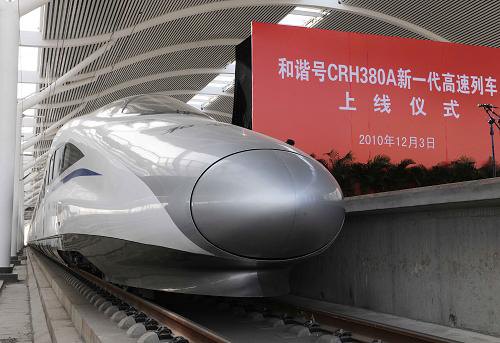US: Transportation Secretary Wants Us to Be Like Communist China – by Amy Payne
 China’s
attempt at a high-speed rail network is fraught with corrupt officials,
impossible costs, and deadly safety failures. But U.S. Transportation
Secretary Ray LaHood wishes America would follow it as a model.
China’s
attempt at a high-speed rail network is fraught with corrupt officials,
impossible costs, and deadly safety failures. But U.S. Transportation
Secretary Ray LaHood wishes America would follow it as a model.LaHood told The Cable last week: “The Chinese are more successful [in building infrastructure] because in their country, only three people make the decision. In our country, 3,000 people do, 3 million. In a country where only three people make the decision, they can decide where to put their rail line, get the money, and do it. We don’t do it that way in America.”
His comments are stunning. Yes, that’s how Communists do it: A few people make decisions for the country and control the money, land, resources, and workers. And how has that worked out?
“Rather than demonstrating the advantages of centrally planned long-term investment, as its foreign admirers sometimes suggested, China’s bullet-train experience shows what can go wrong when an unelected elite, influenced by corrupt opportunists, gives orders that all must follow — without the robust public discussion we would have in the states.” That sounds like a direct rebuttal to LaHood, but Washington Post editorial writer Charles Lane wrote that back in April 2011.
The Telegraph (U.K.) reported in February that 70 percent of China’s railway projects had been suspended, as its railways ministry attempted to continue deficit financing while facing slow ticket sales. Last year, a deadly train crash brought safety concerns and corruption at the highest levels of the railway to light.
The bottom line is that high-speed rail is like pouring money down a hole. China’s official institutions aren’t known for transparency, but according to the Voice of America, “Even the [Chinese] national research institution, the Academy of Science, reported last year that at current investment and estimated passenger numbers, thetrains will never collect enough in fares to repay construction loans.”
LaHood—and President Obama—advocate high-speed rail in America by evoking the image of thousands of workers on the project. It’s part of their stimulus-funded plan to get America back to work. But once again, China’s experience demonstrates that government spending on infrastructure has not helped the Chinese economy.
The Obama Administration has an ally in California Governor Jerry Brown (D), however. On Friday, Democrats in the California state Senate narrowly approved funding for the first stage of a high-speed rail line there. They faced a deadline for getting $3.3 billion in federal stimulus money, which drove the timing of the vote. The state is now authorized to start selling $4.5 billion in bonds. The key is that this first stage is barely a beginning, as CBS Sacramento columnist Aaron McLear explained: “The plan sold to voters cost $46 billion; now the state says it will cost $68 billion, hoping that the federal government and private investors make up the bulk of the cost. But as the non-partisan research group California Common Sense pointed out this week, when one factors in typical large infrastructure project overruns, the cost is closer to $99 billion, with $82 billion of that funding unsecured. If the Feds don’t pick up half the tab the cost soars to $203 billion.”
That’s a pretty big “if”—”if” the funding comes in. One Democratic state senator who voted against the project exposed this reasoning: “Is there additional commitment of federal funds? There is not. Is there additional commitment of private funding? There is not. Is there a dedicated funding source that we can look to in the coming years? There is not.”
Basically, California lawmakers are just hoping it works out. And they’re ready to tax Californians—and the rest of America—to make that happen. Californians are wise to their situation, and they’re not too keen on diverting endless amounts of money into this hole. Polls show public support for the rail plan has dropped below 40 percent.
Despite public opinion, LaHood declares that the opposite is true, like a character out of Orwell: “There’s no turning back on this. We’re not going to turn back. And you know why? Because that’s what the people want.That’s why… there’s no stopping high speed rail.”
But as the suspension of Chinese railway projects shows, there is stopping it when bullet trains collide with fiscal reality. The states of Florida, Wisconsin, and Ohio actually turned down federal money for similar projects, declining to tie their state budgets to the money pit of high-speed rail. They realize that their taxpayers would be on the hook subsidizing the rail line long after the initial infusion of federal cash.
We need less centralized control of transportation, not more. Congress should give states more control over the transportation dollars their drivers already pay in federal gas taxes. States can identify their transportation problems and priorities much better than Washington. Secretary LaHood could not be more wrong.
Quick Hits
- Today, President Obama will finally join the ongoing tax debate, advocating for massive tax hikes on job creators and a temporary delay of hikes for others.
- Spain’s borrowing rate is hitting the bailout danger zone, reports the AP.
- “In Washington, it’s called the Affordable Care Act. In Sacramento, it could be become known as anotherbudget buster,” writes George Skelton of Obamacare’s skyrocketing costs in the L.A. Times.
- More states are instituting Internet sales taxes that will hit consumers shopping online.
- Heritage’s Ted Bromund has been reporting from the U.N.’s Arms Trade Treaty Conference. Wrapping up the first week, he writes that “The totalitarian states are deviously brilliant” and “There are many contentious issues left to be resolved at the conference.
No comments:
Post a Comment